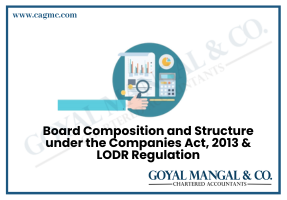 When a company pays dividends before the company’s Annual General Meeting (AGM) and the publication of financial statements, it is known as an interim dividend. Payment is made either quarterly or semi-annually. The board of directors declares an interim dividend and the company’s shareholders ultimately approve it. The company declares and pays an interim dividend from the profit for the financial year. For a better understanding of the concept, let us discuss all the interim dividends.
When a company pays dividends before the company’s Annual General Meeting (AGM) and the publication of financial statements, it is known as an interim dividend. Payment is made either quarterly or semi-annually. The board of directors declares an interim dividend and the company’s shareholders ultimately approve it. The company declares and pays an interim dividend from the profit for the financial year. For a better understanding of the concept, let us discuss all the interim dividends.
|
Table of Contents |
What is a dividend?
Companies can raise capital through two main asset classes, namely debt, and equity. If they choose the second way, then they should pay dividends to shareholders regularly. Companies typically choose to pay dividends to incentivize shareholders who seek income along with stock price appreciation. These dividends paid are generally calculated as a percentage of earnings and distributed per share. It is a company’s liability.
What is an interim dividend?
An interim dividend is a dividend payment made before the company’s annual general meeting and before the publication of the final financial statements. This declared dividend usually accompanies the company’s interim financial statements and is paid monthly or quarterly. The company’s board of directors declares an interim dividend, but the final approval must be given by shareholders.
Sources of distribution of interim dividend
The interim dividend amount will be paid from:
- A surplus in the income statement.
- The profit of the current accounting year in respect of which such interim dividend is paid.
- Profit generated in the financial year preceding the quarter in which such dividend was declared.
Usually, interim dividends are paid out of retained earnings, which already include retained earnings from previous financial years. Until the end of the quarter immediately preceding the date of declaration of the interim dividend, if the company has incurred a loss, then the dividend rate on those shares will not be higher than the average dividend rate during the immediately preceding three financial years.
When declaring an interim dividend, the board of directors will take into account:
- Year-round depreciation
- Tax including deferred company tax throughout the year
- Losses that are expected for the accounting year
- A fixed rate of dividend that must be paid on preferred stock
Calculation of interim dividend
If both an interim and a final dividend are paid in the same fiscal year, the interim dividend is generally lower than the final dividend. The board may decide to keep the interim dividend at a lower rate to avoid disrupting the company’s ability to operate if annual results turn out to be lower than originally expected.
Examples of interim dividends
A company could pay a dividend, and when earnings increase further, the same company could pay another interim dividend. This will help investors maintain dividends without having to give up their cash for a full year. In addition, interim dividends will not accumulate over time, as most annual dividends do. So if you receive a payment that was paid three months ago, it cannot be added to one paid last month.
Interim dividends can be beneficial for investors who want to hold on to high-dividend stocks but need cash available for other expenses. Although these kinds of dividends tend to only cover about half or less than half of a typical annual dividend, they can still offer some amount of income to help fill in the gaps before annual payments start again which may vary from company to company.
How are interim dividends financed?
Interim dividends are paid from retained earnings, which include profits from previous accounting years. It is usually not paid out of the profits of the current year as the same will not be fully realized when the interim dividend is declared.
Process for payment and declaration of interim dividend
The procedure to be followed for the declaration and payment of the dividend is as follows:
- At least seven days’ notice must be given to every director of the company to call a meeting of the board to declare an interim dividend.
- A meeting of the Board of Directors will be convened and all matters related to the payment of the interim dividend will be discussed and further includes:
- Finding out the financial situation of the company
- Amount of dividend to be declared
- Record date fixation
- Opening a bank account to transfer dividends
- Printing and granting authorization to sign dividend guarantees
- The decision of the Board of Directors on the declaration and payment of dividends.
- After the board resolution is passed, a separate bank account needs to be opened with the planned bank.
- Deposit the dividend amount due into this account within five working days of the announcement of such dividend.
- The dividend will be paid to registered shareholders or bankers within thirty days of the declaration of the dividend.
- If the amount of the dividend remains unclaimed or unpaid, such amount shall be transferred to the “Unpaid Dividend Account” within seven days after the expiry of thirty days from the declaration of such dividend.
- Within ninety days of making any transfer to the “Unpaid Dividend Account”, the company shall prepare a statement containing the names, addresses, etc., and also place the same on the website, if any.
- If any person wishes to claim his dividend amount from the Unpaid Dividend account, such person has to apply to the company in Form IEPF-5.
- After seven years from the date of dividend transfer to the “Unpaid Dividend Account”, such unclaimed dividends will be transferred to the Investor Education and Protection Fund.
Interim Dividend vs Final Dividend
The payment of dividends is done based on the number of shares owned. One will receive Rs. 100 in dividend income per year if, for example, he owns 100 shares of company A and the firm pays dividends of Rs.1 every year. If company A doubles its dividend, it will distribute Rs 2 per share, giving investors an annual return of Rs 200. Final dividends are declared and distributed annually along with profits. Companies pay interim dividends out of retained earnings rather than current earnings as in the case of final dividends. Final dividends are announced once profits are calculated against interim dividends, which are paid before the final financial statements for the year are published. A company’s interim dividend may be declared by management before the annual results are published, after which it would be a final dividend.
A final or regular dividend is a certain amount that is distributed quarterly, semi-annually, or annually. It can represent a certain percentage of earnings or net income. It can also be paid from the earnings that remain after the business pays for working capital and capital expenditure (CapEx). Management’s goals and objectives for shareholders will determine the dividend policy or strategy that is used. Interim dividends can be treated the same as final dividends, but because interim dividends are paid before the end of the fiscal year, their financial statements are not audited.
Final words
The interim dividend is declared by the board of directors before the closing of the annual financial statements. It is also considered a corporate debt that cannot be revoked once declared. The Board of Directors shall analyze the financial position of the company before declaring any kind of interim dividend and such dividend shall be paid out of the surplus in the income statement of the company. The interim dividend rate is generally lower compared to the final dividend rate.







